I peered at the Eight Mile River as I hiked upstream through the Pleasant Valley Preserve, 235 acres protected forever by The Nature Conservancy near Lyme, Connecticut.
“Ugh. Tannin water,” I thought.
Streams that flow through watersheds dominated by conifers often run tea stained. The color is caused by tannins, yellow/brown colored organic compounds that leach out of decomposing pine needles. It makes the underwater world of streams dark and imposing.
But that wasn’t much of a deterrent. I started snorkeling freshwater systems in 2007 after watching RiverWebs. The film explores the work of River Ecologist Shigeru Nakano whose early pioneering research was based on snorkeling rivers.
Become a Member
Make a lasting impact for nature when you join The Nature Conservancy.
I wondered what the rivers in my part of the world looked like beneath the surface. I thought I knew these places. I canoed, kayaked and fished them frequently, but never considered this different perspective.
The first stream I chose to snorkel was one of the most impacted in my region. It flowed through a mostly developed watershed and so it endured large volumes of storm water runoff. Its banks were eroding, and each rain resulted in a bottom rearranging flood. I was amazed at the beauty abundance and diversity concealed by the reflective surface, even in this dilapidated stream.
We are losing diversity from our freshwater ecosystems at a frightening pace. And I think part of the reason is because we don’t know what we are losing. Rivers and streams are tucked into the folds of our society out of sight.
And the life they contain is even further removed from consideration. Most people have no concept of the beauty, diversity and complexity hidden from view in rivers and streams.
So I stopped off here at the Eight Mile River, on my way to snorkel freshwater kettle ponds on Cape Cod, to experience it from beneath the surface, and to be amazed.
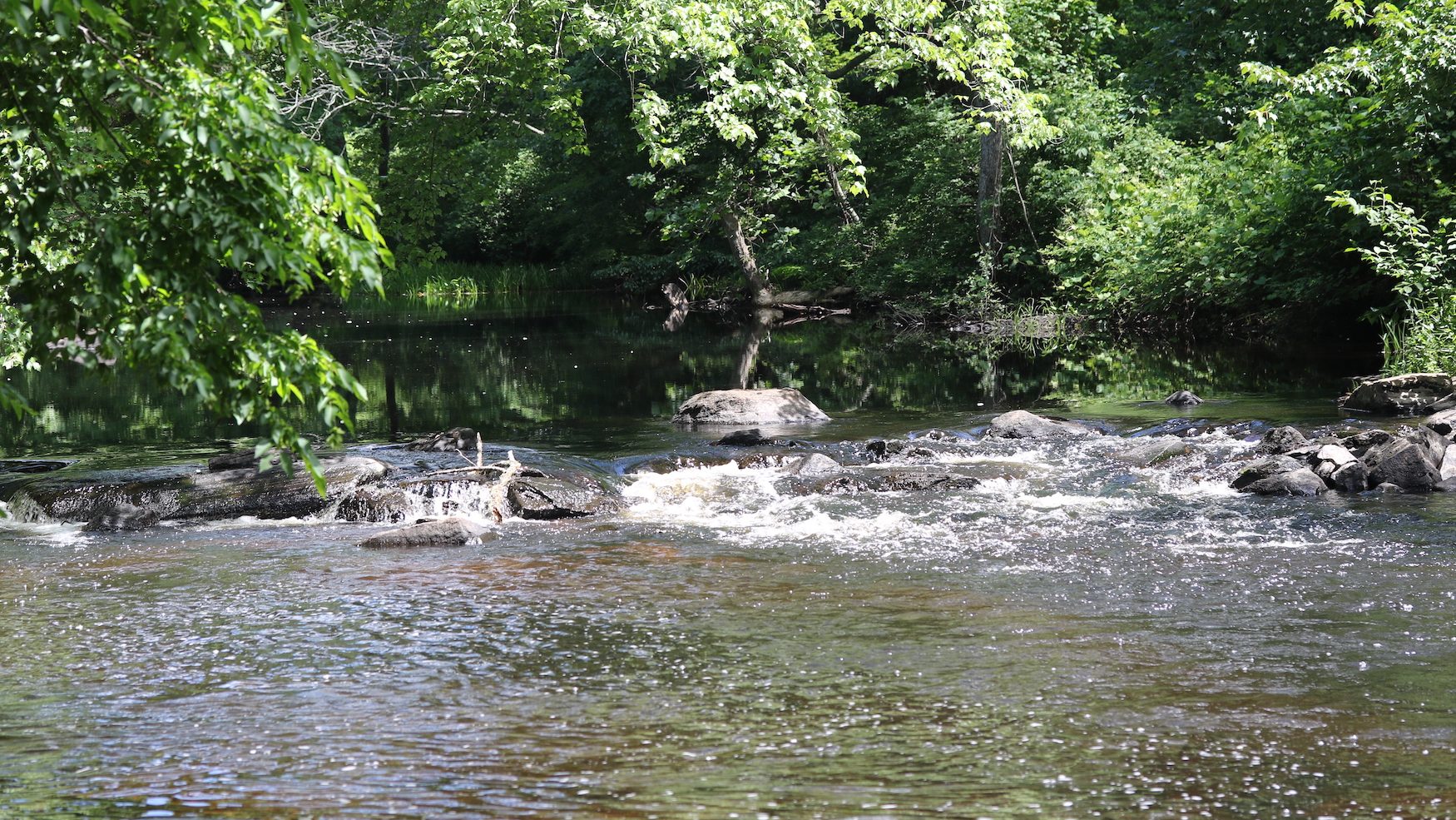
A Wild River of the Northeast
The Eight Mile River is a global heritage site and a designated Wild and Scenic River.
Its 62 square mile watershed is mostly forested and includes 150 miles of tributaries.
The river’s accolades outweighed the tannins, so I kept on. This river is a rare find in the rapidly developing northeastern megalopolis. The 14-mile run is named for where it joins the Connecticut River, eight miles from the Long Island Sound.
I followed the trail away from the river through a floodplain hardwood forest and uphill into a cedar meadow. We often think of land preservation in terms of open space and biodiversity conservation. But the Pleasant Valley Preserve is a great example of the water quality benefits that comes from protecting land.
I stepped over numerous tiny streams, too small to be named, but critically important to the health of the Eight Mile. Development pollutes water with nutrients and sediment and heats storm water runoff.
These 235 acres could have been condos and houses which would cause these tiny tributaries to run warm and cloudy. Instead they are clear and cold. The Eight Mile, and people, benefit.
The trail emerged onto a coarse gravel beach below a short ledge of large boulders. The river flowed over and through the rock, carved out a deeper pool downstream, and widened.
I squeezed into my wetsuit, pulled my mask over my face, knelt on the rocky bottom and drifted through the pool.
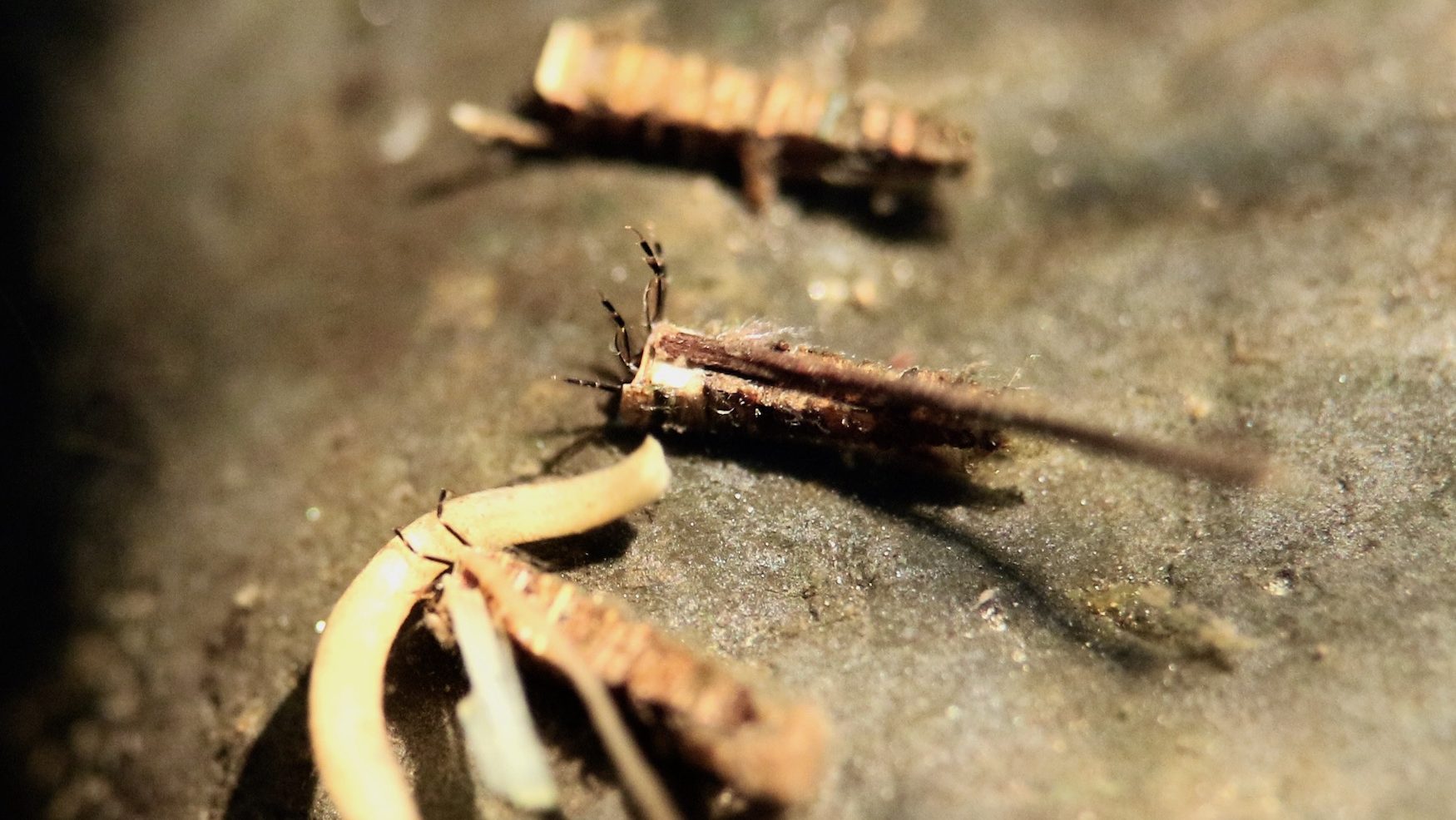
Encounters with Caddisflies
The black rock geology consumed most of the light. The tannin water diffused the rest. The river was clear but dark, and I could only see five feet. Shoals of white quartz pebbles, pushed into the downstream lee of large rocks, glowed orange and the whole place had a dark orange cast.
It didn’t take long for life to become apparent, even in the low light. Eight Mile is rich with caddisflies. Caddisflies are a kind of aquatic insect that live most of their lives as aquatic larvae.
They transform into winged adults whose main purpose is to reproduce. The larvae often construct cases out of sand, gravel, twigs or leaves. The material and design vary by species. Some spin webs that capture food in the drift for the caterpillar like larvae to eat.
The square cases of humpless caddis are constructed of brown and tan pine needle bits woven together with silk produced from glands on their lower jaw and resemble tall thin log cabins tilted on their sides. A line of them were cemented to the top of a rock in the strong current, their openings faced upstream. The caddisfly larvae inside held their legs up into the current to snag food particles as they whizzed by.
One connected a longer twig lengthwise to its case, to serve as a rudder and keep it pointed into the flow. Is this tool use? The use of tools is often considered a sign of higher cognition.
Saddlecase maker caddisflies piled larger pebbles together to make their cases, and they look robust and indestructible.
Snailcase makers sculpted fine-grained sand into snail helix shapes, bejeweled with red, green and orange translucent grains. Groups of these hunkered together in divots in the boulders, shielded from the full force of the current. You can tell a lot about the ecological condition of a river by the aquatic insect community, and the diversity and abundance of caddis in Eight Mile speaks to its quality.

Mussel Memories
The shell of an Eastern elliptio freshwater mussel poked through one of the gravel bars. It was old and eroded.
There are twelve freshwater mussel species in Connecticut. Seven are threatened, endangered or species of concern. Elliptios aren’t one of those, but freshwater mussels as a class are in trouble.
Seventy two percent of the 302 North American species are extinct, endangered or threatened. Eastern elliptios are the most common freshwater mussel on the Atlantic slope but some populations are declining.
I wondered about the status of the population in this river. In spite of the protected land, and abundant and diverse benthic macroinvertebrates, problems exist. One of those problems was next to the old elliptio shell.
An empty Chinese mystery snail shell was also piled onto the gravel. Chinese mystery snails are invasive species, aquarium escapees, who can significantly alter the ecology of streams they invade by out competing native species for food and space. One of the causes of the ubiquitous decline in North American freshwater mussels is aquatic invasives.
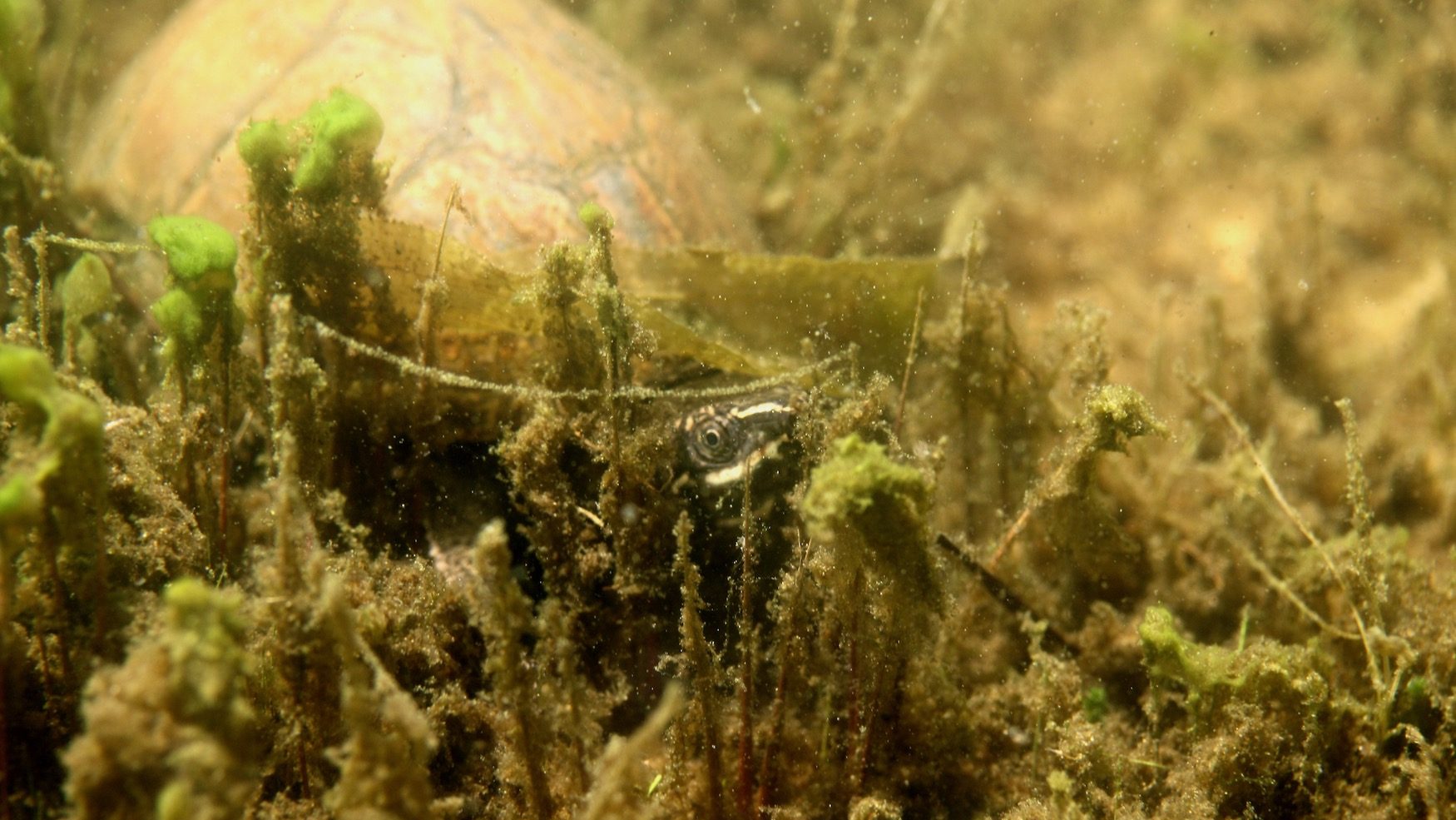
A Musk Turtle Moment
A tiny shadow floated past the mystery snail shells, barely noticeable. A juvenile white sucker, about three quarters of an inch long and silver grey with darker blocky digital patterns on her side, clumsily swam over the gravel flat.
White suckers are common in eastern rivers, and the adults are some of the most powerful, agile swimmers I have ever seen underwater. But this little one was just figuring out how to use currents to her advantage so was pushed around a bit by the water, rather than mastering it like her parents.
A cloud of some kind of other juvenile fish hovered in the center of a slow rotating eddy. They were tiny, just two eyes and a squiggle, and were back lit green in a surreal scene. So new and vulnerable, yet out in the middle away from protection. Maybe they were each other’s defense.
I felt like I was being watched. Each river has its own feel and personality. Eight Mile under water is dark and mysterious, so I assumed that watched feeling was normal for here in these shadowy conditions.
I started to float downstream when two eyes startled me. They peered at me from behind a cobble on the bottom. The musk turtle’s black head was ornamented with thin yellow lines and his two yellow eyes stared at me intently.
I don’t know how long the turtle was watching me, but he was aware of my presence long before I noticed him, and as soon as I made eye contact, his rear legs frantically paddled him away. He disappeared into the distance.
I left the pool, let the river carry me downstream and scraped along a riffle. Common and spottail shiners fed on the food I inadvertently stirred from the bottom in a frenzy of silver side flashes and chaos.
They expertly plucked food I couldn’t see from the water column in tight acrobatic spins and turns. I floated out into the next downstream pool and finally got comfortable with the dark orange hue.
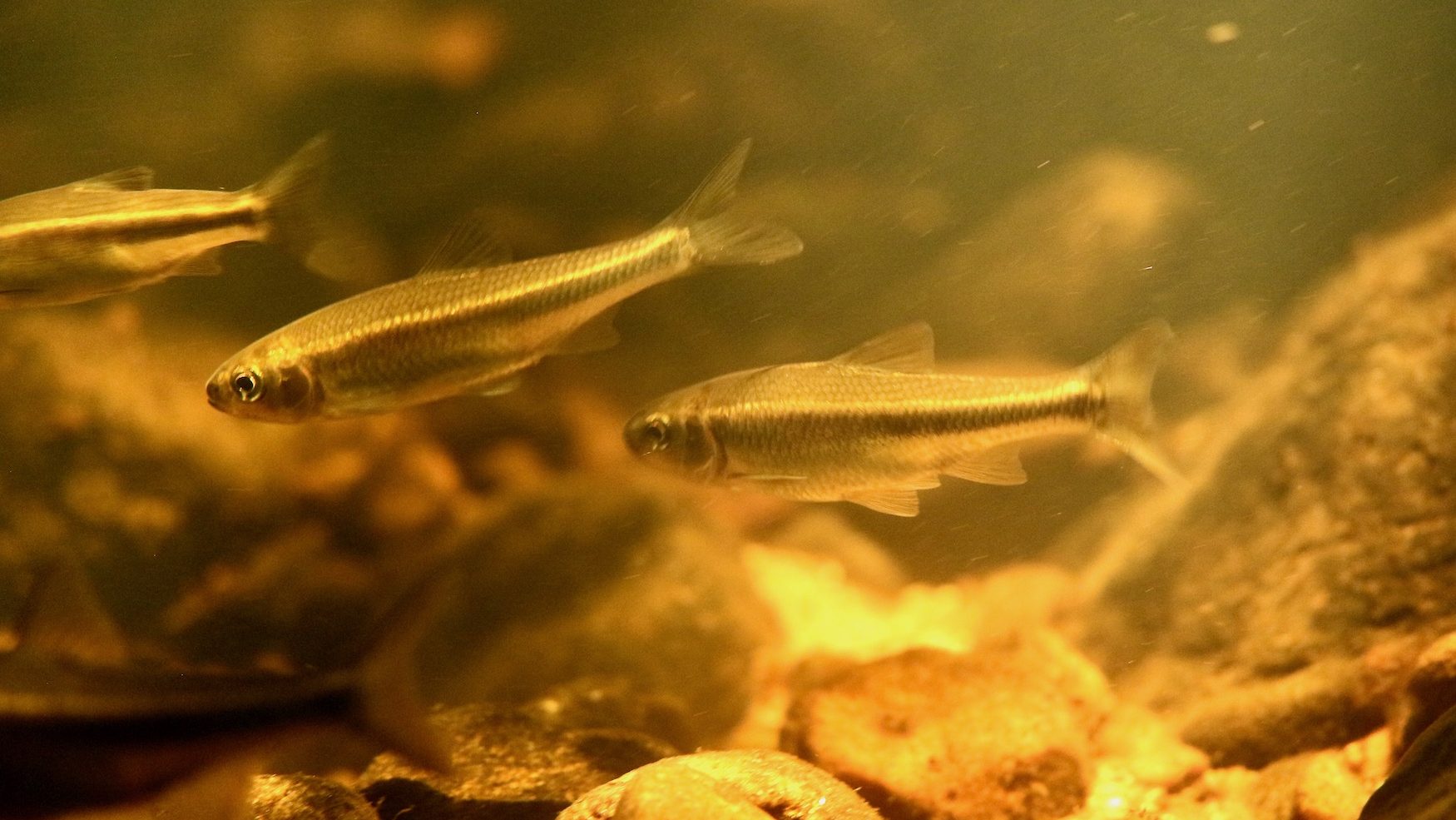
On the Redd
A large area of lighter colored cobbles that had recently been churned up glowed in the distance. They were placed into a two-foot diameter ring, much too organized to be random. This was the nest or redd of a sea lamprey.
Sea lamprey get a bad rap for the damage they do in the Great Lakes where they are invasive. But they are part of the native fabric here, one of a multitude of migrants that make their way between fresh and salt water, ocean and river.
I hoped to see the 3-foot-long chestnut brown tube of muscle. Lamprey are prehistoric fish, predating even sharks. They don’t have jaws and their gills are more primitive than the slits sharks have, and are just holes called spiracles.
They use their sucker disc mouths to suck the life out of fish, and to carve a depression in the bottom by moving cobble from the center and arranging it into a ring. This is their nest where the male fertilizes eggs released by a female. Their strength is demonstrated by the bowling ball sized rocks rolled out of this redd.
There wasn’t a male here. I must have just missed him by days. Hopefully he successfully spawned and his fertilized eggs are safely nestled in the interstices on the rocky bottom.
They will hatch into filter feeding amocetes, who look more like worms than fish, and will live in the Eight Mile, filtering and cleaning her waters for 6 years before transforming into juvenile lamprey. The juveniles head out to sea where they grow into parasitic adults.
There are other migrants who should be here: Eels, herring, shad, Atlantic salmon. The season is wrong for some of these. For others who used to be common, we have decimated their populations so that the chance of seeing them has become remote.
I noticed motion just on the periphery of sight and slowly drifted in. The cause came into focus.
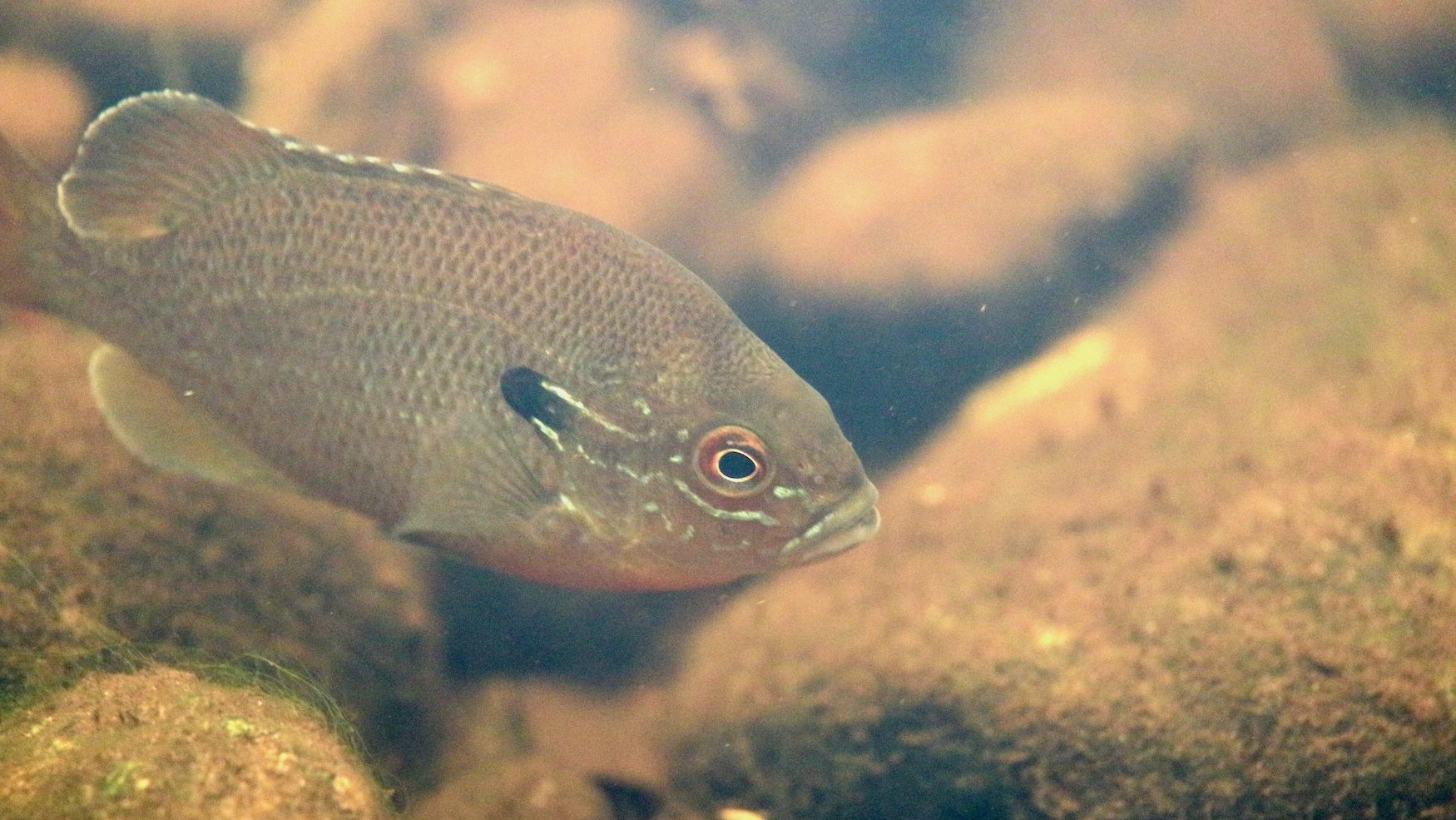
A male redbreast sunfish guarded his nest. It was the same concept as the lamprey redd—a divot carved into the bottom—but on a smaller scale. The sunfish was brilliantly colored.
A bright red breast pierced through the dark orange. Turquoise lightning bolts traversed his gills. He came out of his nest to threaten me and he looked like he puffed himself up, flared his pectoral fins to make himself look bigger.
His red breast got brighter. After a few moments of intimidation, he spun around, went back onto his nest, fanned the eggs I couldn’t see in the bottom of the bowl, and came back out at me. I was taking this fish off his nest, leaving his eggs exposed to real predatory threats, so I backed away, and gave his nest a wide berth as I snorkeled to the shoreline.
I hauled out on a few rocks a half mile downstream from where I started. I could see the sunny back on his nest, though he was much less vibrant from this perspective compared to underwater. I was glad to see him attending to his eggs; his behavior returned to normal.
All of our actions have consequences. Even innocent ones like watching a brightly colored sunfish.
The effect of the actions of the Nature Conservancy’s efforts here at the Pleasant Valley Preserve is clean water coming off the 235 protected acres which allows all this life in a half mile underwater on the Eight Mile River to thrive.




Such a fun and great read! You have me chomping at the bits to snorkel in the Eight Mile River.
Very interesting to read about all of this tiny life that I didn’t even know exists. I won’t be stomping around in little streams and messing up their homes any longer.
Thank you for sharing this.
Great experience on the Eight Mile River, Keith, and a noble pursuit to snorkel as many rivers as you can. One day perhaps you will get the chance to snorkel or dive the Tapajos River, a clear water tributary of the
Amazon: do it by day and by night to see the different fish faunas. While there try some of the tannin rich black water rivers or lakes for an entirely different experience, and one that is more auditory than visual.